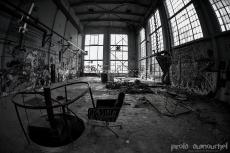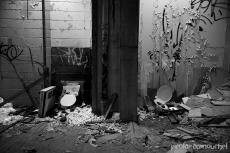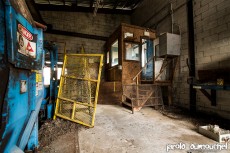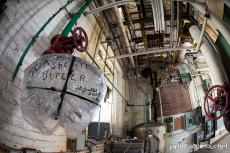Sold for $ 1 in 2004 in exchange of the promise to clean up the heavily polluted soil, the land of more than 3.5 million square feet has not found its commercial and residential purpose promised by March Group, the current owner. However, when...
The abandoned workshop
The day I've missed the chance to get a new friend
This is the story of the saw manufacturing industry where methods have not changed for decades. The result is this building that has certainly been enlarged over the years, but the interior has retained its old-fashioned charm. You should know that the manufacture of saws requires a mechanical process, but also handcrafted. The expertise of the workers is therefore crucial and above all, a guarantee of quality. On paper, manufacturing is relatively straightforward: take a steel sheet, round cut and then hammered. But in reality, the number of machines required makes its manufacturing a little more complex.
The building is associated with its most important occupant where its adventure start in 1891 with the creation of the company. Built in 1880, the building will be first used by a merchant and shopkeeper in the city. In 1911, the building served as a warehouse which then is bought and converted into a workshop. We will install the pulleys on the ceiling (which are still there today), add a forge (which has since been replaced, but whose remains are still there) and the building will be expanded over the years.
One of the most interesting parts of the workshop is definitively the boss office. On the one side, a glass wall to keep an eye on operations and on the other site, cabinets who looks like a sacristy with an old phone booth in the corner where the boss go for its calls when the noise was too loud in the factory.
In the attic, there is a lot of old stuff like fifty years old typewriters, mussels piled in old wooden boxes and old parts of any kind.
True witness to a century of mechanical production but also small-scale, the building is now listed as cultural heritage. Abandoned for a new, larger and more modern workshop, the building is now on sale, waiting for a new destiny which, hopefully, will not pass through its demolition. Demolition also desired by neighbors who see a fire risk (the entire building is wood) rather than a piece of history of this city.
"If you think it's beautiful, you and I won't be friends" said the neighbour half-comic half-serious ... Unfortunately, my visit has concluded without a new friend!
Related content
The plant itself is definitively not as great at we saw in other places. Located in the heart of Pointe-Saint-Charles neighborhood of Montreal, this two storey building has no longer the cachet of its heyday. While neighboring buildings are...
The advantage of a 4 hours ride to visit an abandoned sawmill is that we increase our chances of finding an intact place without the slightest trace of vandalism. Or at least, very little.
All along the road, the fear of finding a...
For several times I passed by this little factory located in an old industrial area in the Eastern Townships, but I never been inside. Each time, I wondered if it was still active or abandoned. I must say that several tiles were broken, but I was...
































